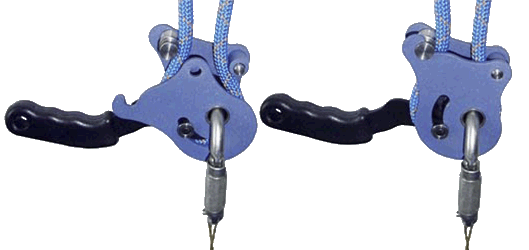Technical Details
I acquired my Krok Snail in 2012 when Alex Dniprovsky sent me a box of donations originating from Alex Kostromitinov, CEO of Krok.
My Krok Snail is 87 mm. tall, 185 mm. wide, 46 mm. thick, and weighs 332 g.
The descender consists of a back plate that supports two bollards on the top and a central
rotating bollard. A handle behind the back plate pivots on the central bollard axle, as does a front plate. The front and back plates are 87 mm.
tall, 70 mm. wide, irregular shaped pieces of 3.25 mm. aluminum
plate. The left bollard is turned stainless steel. It has a distal groove to engage a slot in the front plate, a U-shaped rope groove with 13.9 mm. side and 12.0 mm. central diameters across an 8.0 mm. width, and a 6 mm. threaded post that allows attaching this bollard to the rear plate with a lock nut. The right bollard is a 19.9 mm. diameter, 14.7 mm. long hollow steel cylinder press fit to the back plate. This cylinder supports a central spring-loaded stainless steel pin for latching the front plate. The pin has knurled thumb knob on the rear.
The rotating bollard pivots on a turned stainless steel axle. The axle has a 13.2 mm. central bore. The rear of the
axle is countersunk and the front is rolled over to support the front plate. The
axle is about 35.5 mm. below the right rope channel bollard (center to center). The pivoting bollard
is a 50 mm. diameter, 14 mm. thick steel circle with 45 mm. minor diameter U-groove turned on the edge. The pivot
hole lies about 12 mm. below the cylinder’s center. A 20 mm. hole in the bollard helps reduce weight.
There
is a 184 mm. long control handle that pivots on the main bollard axle, behind the rear plate. A stud from the rotating bollard passes through an arcuate slot in the rear plate and a similar slot in the handle, and is secured with a threaded stainless steel bushing. The handle is 3.25 mm. aluminum plate with an 85
mm. long rubberized plastic handle
molded on the distal end.
All non-stainless metal components are painted. The handle is stamped with the Krok logo, a book-wit-an-"i" icon.
Rigging
the descender involves pulling the pin and swinging the front plate open, then looping a bight over the rotating bollard. This may be difficult
with some stiff caving ropes, since the maximum clearance between the front plate and the top left bollard is only
about 11 mm. Another problem is that many carabiners will not fit through the attachment hole.

As one descends, friction on the rotating bollard will tend
to rotate the handle upward, and the off-centered mounting will
cause the rotating bollard to squeeze the rope against the
rope channel bollards. Pulling the handle down relieves this pressure,
allowing one to descend.
The translated cut sheet for the snail states that "the strength of a safety-release mechanism SNAIL meet the requirements of EN341 ’Devices for descent.’"

For far more content, use a larger monitor and a full-width window.
Hundreds of cell phone users complained and asked me to for a simpler, mobile friendly site. In particular, they wanted me to limit each page to a small number of pictures and minimize my use of text. This new site provides what they asked for.


